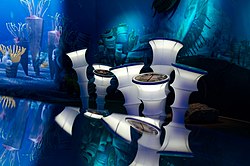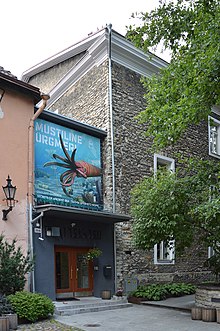
The Natural History Museum in London is a museum that exhibits a vast range of specimens from various segments of natural history. It is one of three major museums on Exhibition Road in South Kensington, the others being the Science Museum and the Victoria and Albert Museum. The Natural History Museum's main frontage, however, is on Cromwell Road.

The French National Museum of Natural History, known in French as the Muséum national d'histoire naturelle, is the national natural history museum of France and a grand établissement of higher education part of Sorbonne Universities. The main museum, with four galleries, is located in Paris, France, within the Jardin des Plantes on the left bank of the River Seine. It was formally founded in 1793, during the French Revolution, but was begun even earlier in 1635 as the royal garden of medicinal plants. The museum now has 14 sites throughout France.

World Museum is a large museum in Liverpool, England which has extensive collections covering archaeology, ethnology and the natural and physical sciences. Special attractions include the Natural History Centre and a planetarium. Entry to the museum is free. The museum is part of National Museums Liverpool.

Annie Montague Alexander was an explorer, naturalist, paleontological collector, and philanthropist.

The Florida Museum of Natural History (FLMNH) is Florida's official state-sponsored and chartered natural history museum. Its main facilities are located at 3215 Hull Road on the campus of the University of Florida in Gainesville.

The Natural History Museum of Los Angeles County is the largest natural and historical museum in the western United States. Its collections include nearly 35 million specimens and artifacts and cover 4.5 billion years of history. This large collection comprises not only of specimens for exhibition, but also vast research collections housed on and offsite.

The Denver Museum of Nature & Science is a municipal natural history and science museum in Denver, Colorado. It is a resource for informal science education in the Rocky Mountain region. A variety of exhibitions, programs, and activities help museum visitors learn about the natural history of Colorado, Earth, and the universe. The 716,000-square-foot (66,519 m2) building houses more than one million objects in its collections including natural history and anthropological materials, as well as archival and library resources.

The Natural History Museum in Lima, is Peru's most important museum of natural history. It was established in 1918 and belongs to the National University of San Marcos.
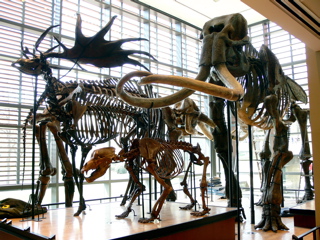
The Beneski Museum of Natural History, Amherst College is located on the campus of Amherst College in Amherst, Massachusetts. It showcases fossils and minerals collected locally and abroad, many by past and present students and professors. The Museum is located in the Beneski Earth Sciences Building, completed in 2006. It is a member of Museums10.
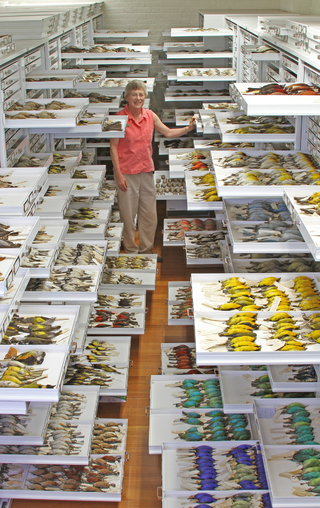
The Museum of Comparative Zoology is a zoology museum located on the grounds of Harvard University in Cambridge, Massachusetts. It is one of three natural-history research museums at Harvard, whose public face is the Harvard Museum of Natural History. Harvard MCZ's collections consist of some 21 million specimens, of which several thousand are on rotating display at the public museum. In July 2021, Gonzalo Giribet, Alexander Agassiz Professor of Zoology at Harvard and Curator of Invertebrate Zoology, was announced as the new director of the museum.

The Finnish Museum of Natural History, established in 1988, is a research institution under the University of Helsinki in Finland, based in Helsinki, Finland. It is a natural history museum responsible for the national botanical, zoological, geological and paleontological collections, which consist of samples from around the world. The collections serve scientific, public informational and educational purposes.

The Natural History Museum of the University of Pisa, located in the city of Pisa in Tuscany, Italy, is a renowned institution dedicated to the study and display of natural history. The museum is home to one of the largest collections of cetacean skeletons in Europe, showcasing an impressive array of marine mammal specimens. In addition to its extensive cetacean holdings, the museum's oldest collections include seashells amassed by the Italian invertebrate scientist, Niccolò Gualtieri. Serving as both an educational and research institution, the museum invites visitors and scholars to explore the diversity and complexity of the natural world.
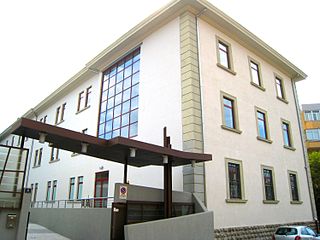
Civico Museo di Storia Naturale di Trieste is a natural history museum in Trieste, northern Italy. It contains several collections, including more than two millions botanical, zoological, mineralogical, geological, and paleontological specimens.

The Museum of Evolution of Uppsala University is a natural history museum in Sweden, and holds Scandinavia's largest fossil collection of dinosaurs. The number of items in today's collection, which spans zoological, paleontological and mineralogical specimens, is approximately 5 million unique pieces, of which only a fraction are exhibited. Expeditions to China in the 20th century unearthed numerous unique paleontological treasures. The museum's collection contains three teeth of the Peking Man, found by paleontologist Otto Zdansky during an expedition to Zhoukoudian in 1921. Due to its large collection of type specimens the museum is an important establishment in the field of biological systematics, and it maintains an active exchange with other scientific institutions worldwide.

The Idaho Museum of Natural History (IMNH) is the official state natural history museum of Idaho, located on the campus of Idaho State University (ISU) in Pocatello. Founded in 1934, it has collections in anthropology, vertebrate paleontology, earth science, and the life sciences. Additionally, it contains an archive of documents and ethnographic photographs.

The Natural History Museum of Denmark is a natural history museum located in Copenhagen, Denmark. It was created in 2004 through the merger of Copenhagen's Zoological Museum, Geological Museum, Botanical Museum and Central Library, and Botanical Gardens. It is affiliated with the University of Copenhagen. While the Botanical Gardens and the buildings and exhibits of the Geological Museum have been maintained, the old Zoological Museum closed in 2022 and will become part of the new combined Natural History Museum complex in 2025.
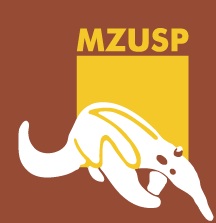
The Museum of Zoology of the University of São Paulo is a public natural history museum located in the historic Ipiranga district of São Paulo, Brazil. The MZUSP is an educational and research institution that is part of the University of São Paulo. The museum began at the end of the 19th century as part of the Museu Paulista; in 1941, it moved into a dedicated building. In 1969 the museum became a part of the University of São Paulo, receiving its current name.

A scientific collection is a collection of items that are preserved, catalogued, and managed for the purpose of scientific study.
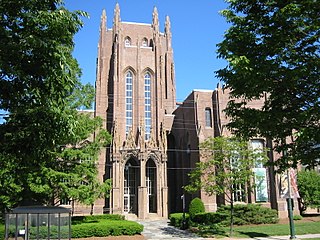
The Peabody Museum of Natural History at Yale University is one of the oldest, largest, and most prolific university natural history museums in the world. It was founded by the philanthropist George Peabody in 1866 at the behest of his nephew Othniel Charles Marsh, an early paleontologist. The museum is best known for the Great Hall of Dinosaurs, which includes a mounted juvenile Brontosaurus and the 110-foot-long (34 m) mural The Age of Reptiles. The museum also has permanent exhibits dedicated to human and mammal evolution; wildlife dioramas; Egyptian artifacts; local birds and minerals; and Native Americans of Connecticut.

The Natural History Museum is a museum in Prague in the Czech Republic. It is one of the five components of the National Museum and currently consists of eight departments: the Mineralogical and Petrological, Paleontological, Mycological, Botanical, Entomological, Zoological, Anthropological, and the Ringing Station. The Natural History Museum employs over 80 people, and its collections contain more than 15 million objects, of which only a fraction are exhibited. Ivo Macek has been the director of the museum since 2015.
